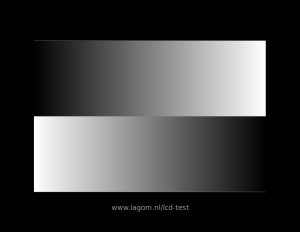I think that I'm blind. I see some small band, but they are so thin that they really do not bother me.
Based on your description, that is normal. This has to do that the LCD panel in the Surface Pro is a 6-bit color per channel (red, green, and blue are channels, all 3 of them).
The massive majority (~99.99%) of consumer grade TN panels are 6-bit panels
All, if not, nearly all tablet, phone, and laptops with an IPS displays, are 6-bit panels
All low cost IPS desktop monitoes are 6-bit panels.
Only the expensive consumer grade IPS panels are true 8-bit panels.
The content we view are in 8-bit per channel, so the display does dithering techniques, and/or color emulation tricks (takes 2 colors that it can produce, and switch between them repeatedly bto try and make you see the color it can't produce. This is called FRC, or Frame Rate Control. A variation of this technique is A-FRC, which stands for Advance Frame Rate Control, and that just means that the monitor has a color processor, which is uses to emulate significantly better the missing colors. Usually A-FRC are found on true 8-bit panels, because they cost already so much, it targets a consumer market that are willing to spend a premium price for a premium product. In such case, A-FRC is used to emulate 8-bot colors, as the panel is already true 8-bit, but rather emulate 10-bit colors.
The color processor is used, for really improving the color reproduction, based on the monitor color settings, which is something that the consumers interested in a true 8-bit panel, would be, well interested in. I mean, if you invest in a true 8-bit panel, it is because you are interested in getting the best color you can get. And by "you can get", I mean budget wise, as you want pin point color accuracy, then you go with pro grade monitors (like the ones from NEC or the Japanese company: EIZO), and use a supported color calibrator to adjust the monitor settings directly and generate a color profile to load in Windows and/or image editing software.
For price comparison between 6-bit and 8-bit panels (for your own knowledge. Please note that these are 16:10 monitors and not 16:9, so there is a premium for this already on both choices. The resolution on both is: 1920x1200 and not 1920x1080)
6-bit:
Dell UltraSharp 24 Monitor - U2412M : Parts & Upgrades | Dell Canada
8-bit:
Dell UltraSharp 24 PremierColor Monitor - U2413 : Parts & Upgrades | Dell Canada
As you can see, going true 8-bit, is a nice premium, which is somewhat similar between brands... the above I picked Dells monitors, but it applies with other manufactures.

